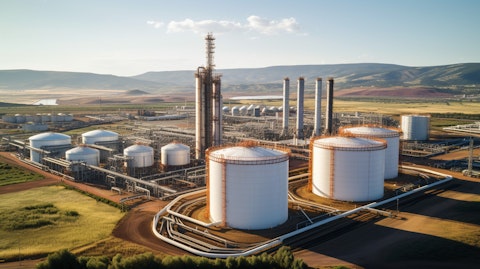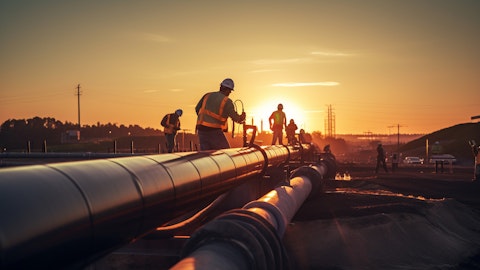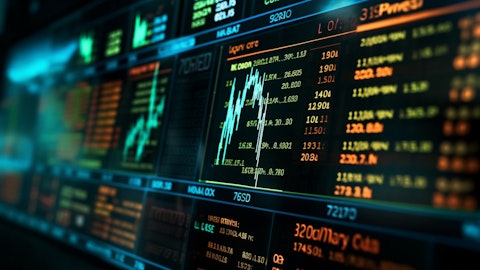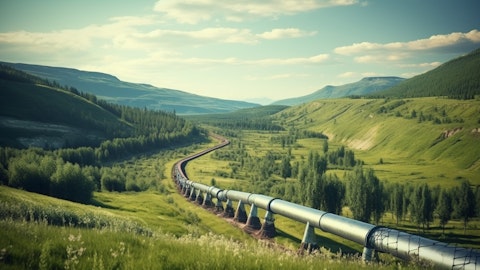Enterprise Products Partners L.P. (NYSE:EPD) Q4 2023 Earnings Call Transcript February 1, 2024
Enterprise Products Partners L.P. beats earnings expectations. Reported EPS is $0.72, expectations were $0.66. Enterprise Products Partners L.P. isn’t one of the 30 most popular stocks among hedge funds at the end of the third quarter (see the details here).
Operator: Good day and thank you for standing by. Welcome to the Q4 2023 Enterprise Products Partners LP Earnings Conference Call. At this time, all participants are in a listen-only mode. After the speakers’ presentation, there will be a question-and-answer session. [Operator Instructions] Please be advised that today’s conference is being recorded. I would now like to hand the conference over to your speaker today, Randy Burkhalter, Vice President of Investor Relations.
Randy Burkhalter: Thank you, Josh. Good morning everyone and welcome to the Enterprise Products Partners conference call to discuss fourth quarter 2023 earnings. Our speakers today will be Co-Chief Executive Officers of Enterprise’s general partner, Jim Teague and Randy Fowler. Other members of our senior management team are also in attendance for the call today. During this call, we will make forward-looking statements within the meaning of Section 21E of the Securities and Exchange Act of 1934 based on the beliefs of the company, as well as assumptions made by and information currently available to Enterprise’s management team. Although management believes that the expectations reflected in such forward-looking statements are reasonable, it can give no assurance that such expectations will prove to be correct.
Please refer to our latest filings with the SEC for a list of factors that may cause actual results to differ materially from those in the forward-looking statements made during this call. And with that, I will turn it over to you Jim.
Jim Teague: Thank you, Randy. We generated $7.6 billion of distributable cash flow in 2023, providing 1.7 times coverage, and we retained $3.2 billion. We set nine financial records and 13 operating records in 2013. Our 2023 operating results included records in NGL pipeline transportation, ethane exports, total NGL marine terminal volumes, NGL fractionation volumes, fee based natural gas processing volumes and crude pipeline and natural gas transportation volumes barrels of oil equivalent per day enterprise transported a record 12.2 million barrels a day in 2023, compared to 11.2 million barrels a day in 2022. During the fourth quarter, we transported 12.7 million barrels a day, compared to 11.5 million barrels a day in the fourth quarter of 2022.
We exported a record 2.3 million barrels a day of liquid hydrocarbons. That includes everything from crude oil to LPGs to ethane, refined products and basic petrochemicals, ethane and propylene. When you look at our exports, it’s clear that enterprise is not a one trick pony. It’s quite remarkable that volumes across all our pipes and facilities increased sequentially each quarter in 2023, supported by the strong supply and demand fundamentals for hydrocarbons from the Permian and other basins we serve integrated with the midstream services we have, including exports that we just discussed. Relative to commodity markets, 2023 was a relatively weak year, especially for natural gas and natural gas liquids. Nonetheless, Enterprise proved once again that we don’t need really high prices to make substantial returns.
The financial records and 13 operating records summarized were achieved in a commodity price environment where natural gas prices were down almost 60% from 2022, crude was down nearly 20%, propane was down 36%, ethane was down almost 50%, and the NGL processing basket was down 35%. Relative to the several 2023 records at our marine terminals, we have long said that hydrocarbons would price to export proven once again in 2023. In growth capital during 2023, we completed construction of $3.5 billion of projects. Significant assets put into service include two new natural gas processing plants in the Permian Basin and our 12th NGO fractionator in Chambers County. All of these assets were essentially full after operations began. While production of our PDH 2 facility was completed in the third quarter of 2023, we spent much of the remainder of the year addressing startup issues.
As a result, this plant did not meet our expectations and earnings in 2023. We believe most of these issues have been resolved and we anticipate much higher utilization rates this year. We began 2024 with 6.8 billion of major organic projects under construction, with three projects representing approximately $1.1 billion in capital investment expected to be completed this year. Major 2024 projects include our Texas Western Products pipeline system and two additional processing plants in the Permian. We have considerable amount of growth capital underway. All of these projects provide strategic growth to our system and can add considerable disability to new sources of cash flow. I wanted to take a minute to talk about project 9.3. We started this project in 2022 as an incentive for all employees to find innovative ways to improve the bottom line.
This was especially important as we in the industry were re-engaged This was especially important as we in the industry were reengaging after COVID and faced the challenges of a slower global economy in 2023. We achieved the goals we set for ourselves both in 2022 and 2023. We are very proud of our employees for that accomplishment. That said, we will not have a Project 9 type program for 2024. You’ve always heard me say, if you want to know where we’re going, look at what we’re doing. The Permian Basin has been the cornerstone for much of our growth capital. As we look at 2024 and beyond, we see supply and demand opportunities as the Permian continues to grow and the world continues to have an ever-increasing appetite for U.S. hydrocarbons.
We noted in the press release that these may be the most geopolitically challenging times since World War II, but it’s abundantly clear that all of this chaos is leading itself to a growing appetite for the most stable hydrocarbon supplies in the world, the USA, in spite of government and regulatory challenges. Without a doubt, relative to energy, our nation’s biggest geopolitical challenges continue to be self-inflicted. Enterprise has one of the world’s leading natural gas liquids franchise, and we have the liquids hydrocarbon storage and export franchise. On top of all of that, we have a dedicated employee base that creates value, regardless of the environment. 2023 marked our 25th anniversary as a public company. It’s been a great quarter century.
It has been for the U.S. energy industry. It included the downfall of the energy merchants, the great financial crisis, the innovation of the E&P and oil field service industries to unlock the potential of the Shell plays, which is still continuing. It included the near-debt and remarkable renaissance of the U.S. petrochemical industry, from having the highest cost feedstock pre-Shell to now the lowest cost. It included two OPEC price wars, a once-in-a-century pandemic, and the re-emergence of geopolitical upheaval. During this time, we stuck to our objectives of investing capital at reasonable returns, providing reliable value-added services to customers, consistently returning capital to our partners, and increasing the value of the partnership for the long-term.
During this time, the enterprise value of the partnership has grown from $1.2 billion to almost $90 billion. The value of our partnership units has increased almost 400%. We increased our distribution 25 consecutive years at an approximately 7% compound annual growth rate. We’ve returned $52 billion of capital to investors through distributions and buybacks. We have high-quality employees, and we thank our employees, we thank our customers, our service providers, our banks, and our investors for their contributions to this success. We’re looking forward to the exciting opportunities and challenges for the next 25 years as the world’s population, quality of life, and demand for energy reaches new heights. Put frankly, based on what I see in the future for energy, I’d give anything if I could turn the clock back and be 50 years old.

With that, I’ll turn it over to Randy.
Randy Fowler: All right. Thank you, Jim. Good morning, everyone. Starting off with the income statement, the net income attributable to common unit holders for the fourth quarter of 2023 was $1.6 billion or $0.72 per common unit on a fully diluted basis. This compares to $1.4 billion or $0.65 per common unit for the fourth quarter of 2022. Adjusted cash flow from operations, which is cash flow from operating activities before changes in working capital, was $2.2 billion for the fourth quarter of 2023 compared to $2.1 billion for the fourth quarter of 2022. We declared a distribution of $0.515 per common unit for the fourth quarter of 2023, which is a 5.1% increase over the distribution declared for the fourth quarter of 2022.
The distribution will be paid February 14th to common unit holders of record as of the close of business on January 31st. In the fourth quarter, the partnership purchased 3.7 million common units off the open market for $96 million. Total purchases for 2023 were $187 million or 7.2 million common units, bringing total purchases under our buyback program to over $900 million. I mentioned it on the last call, looking at our five largest midstream peers by market cap. Since 2019, Enterprise is the only midstream energy company to reduce absolute outstanding units outstanding without significant asset sales. In addition to buybacks, our distribution reinvestment plan and employee unit purchase plan purchased a combined 6.6 million common units on the open market for $172 million during 2023.
For 2023, Enterprise paid out approximately $4.3 billion in distributions to limited partners. These distributions combined with the buybacks for the year, resulting in our having a payout ratio of adjusted cash flow from operations of 56% and a payout ratio of adjusted free cash flow of 94%. Total capital investments in the fourth quarter of 2023 were $1 billion, which included $823 million for growth capital projects, $65 million for the acquisition of a small natural gas storage facility that we have historically leased, and $129 million of sustaining capital expenditures. Capital investments for the year of 2023 were $3.3 billion, which includes $2.75 billion of organic growth capital projects, $100 million in asset acquisitions, and $413 million of sustaining capital expenditures.
During the third quarter call, we estimated $3 billion of organic growth capital expenditures in 2023 and a range of $3 billion to $3.5 billion in 2024. Due to the timing of expenditures, we had approximately $250 million of CapEx shift from 2023 into 2024. Therefore, we now expect our 2024 growth capital expenditures to total $3.25 billion to $3.75 billion. We expect 2024 sustaining CapEx will be approximately $550 million, which includes dollars for planned turnarounds at PDH-1, our IBDH, and our high-purity isobutylene facility. These scheduled turnarounds typically occur every three-to-four years for these type plants. Our total debt principal outstanding was approximately $29 billion as of December 31, 2023. Assuming the final maturity date of our hybrids, the weighted average life of our debt portfolio was approximately 19 years.
Our weighted average cost of debt is 4.6%. At December 31, approximately 96% of our debt was fixed rate. Our consolidated liquidity was approximately $3.9 billion at the end of the fourth quarter, which includes availability of our credit facilities and unrestricted cash. Adjusted EBITDA, as Jim mentioned earlier, was $9.3 billion for 2023. We ended the year with a consolidated leverage ratio of 3.0 times on a net basis after adjusting debt for the partial equity treatment of our hybrid debt and reduced by partnerships unrestricted cash on hand. Our leverage target remains three times, plus or minus a quarter term, so 2.75 times to 3.25 times. In January, we issued $2 billion of senior notes comprised of $1 billion of three-year notes at a coupon of 4.6% and $1 billion of 10-year notes at a 4.85% coupon.
The proceeds from this offering will go toward an upcoming $850 million debt maturity in February, I guess this month, and funding our capital expenditure program. We appreciate the continued support of our debt investors. Moving on to future events, Enterprise will host an analyst and investor call on Wednesday, April 3. This will be in lieu of our in-person analyst day. This call will include overviews on our current outlook, near-term objectives, allocation of capital, as well as fundamentals updates from Tony. Q&A will follow our prepared remarks. More information will be provided in the coming weeks. Before we open the call up to questions, Jim and I would like to take a moment to recognize Randy Burkhalter, our Vice President of Investor Relations.
After a 46-year career in the energy industry, Randy has announced his retirement for April of this year. Randy has led our investor relations effort for the past 21 years, when he joined us shortly after our acquisition of the Mid-America and Seminole pipelines. Through the annual Institutional Investor Magazine, all American team surveys, Enterprise and our investor relations team have been consistently recognized by the sell side and buy side community as one of the best in the midstream sector. Randy has been integral to leading this effort. We are grateful for Randy’s service, his integrity, his attention to customer service, and his industry-renowned social prowess. Please join us in congratulating Randy on his 46-year career and a job well done.
Most of you have met Libby Strait. Libby will succeed Randy in leading our IR effort. Libby is one of our young All-Stars who joined the company in 2013 and worked in commercial roles of increasing responsibility across several of our business units before joining the IR team 2019. She and Michael Cisarik, another one of our All-Stars, will comprise our IR team.
Jim Teague: Randy, as it relates to Randy Burkhalter, I think it’s fair to say we have already scheduled a quarterly visit by Randy to the building to have a couple of scotches back of our downtown at least once a quarter.
Randy Fowler: With that, I think we’re now ready to open the call-up to questions.
See also 10 Blue-Chip Stocks At 52-Week Lows and 35 Smartest Countries with the Highest IQ in the World.
Q&A Session
Follow Enterprise Products Partners L.p. (NYSE:EPD)
Follow Enterprise Products Partners L.p. (NYSE:EPD)
Operator: Thank you. [Operator Instructions] Our first question comes from Michael Blum with Wells Fargo. You may proceed.
Michael Blum: Thanks. Good morning, everyone, and congrats, Randy. And Jim, please send me the invite for the scotch. Get together. I wanted to start with maybe your latest views on Permian growth in 2024, both for oil and for gas. And then kind of a related topic. Clearly, there seems like there will be need for another Permian gas takeaway. You had talked about a Brownfield project a little while back. It’s been kind of quiet lately. So I wanted to get your latest thoughts on Permian gas takeaway solution in light of your growth outlook.
Tony Chovanec: Hey, Michael, this is Tony. In our last analyst meeting, which was March of 2023, we talked about growth in the United States of, call it, 1.8 million barrels. I’ll just go to oil right now. We gave you some basic metrics as to what happens with the oil. But 1.8 million barrels in the 23, 24, 25 time frame. Obviously, there was a lot of pushback when we published that forecast from all sides, including producers that hadn’t looked at the number like we had. And what I’ll say about that number now, of that 1.8, we said 1.5 in the Permian basin. Certainly, given the performance of producers during 2023, the producer community is on track to meet and likely beat those numbers. And I don’t know how that changes at this pace.
And then the combined growing wedge of PDP that a lot of people forget about in key basins, coupled with the continuous improvement in efficiency and productivity that we see from the producer community. So we’ll talk about it more in early April, but I’ll — I think the clip notes now, what we know is, it’s really going to be hard not to at least meet and likely beat that number as we look at the three year period, very much Permian dominated. Relative to gas pipelines we’ve talked about a simple metrics before for every million barrels incremental that you have with oil, you have somewhere in the neighborhood of available 400,000 to 500,000 barrels of NGLs. And for rich gas, call that anywhere from 3.25 to 3.5 Bcf. Okay. So you do the math, you look at what we have today and incremental capacity over the next two years is coming on is appreciable.
Will there need to be more between now and 2030? Yes, the answer that yes, in some form or fashion. Whether it be brownfield, on existing pipes or another Greenfield pipe.
Michael Blum: Okay, great. Thanks for all that, Tony, maybe we’ll just stand gas. My second question just wanted to ask about the pause in LNG permitting and I know you’re not, you don’t have an LNG asset per se. Curious how if at all this would impact your business in 2024 and beyond. Thanks.
Jim Teague: Okay, Michael, this is Jim. And I guess I wonder, is it truly a pause? Or is it something more? And with those will those projects that are not under construction, but going through the regulatory process be allowed to continue to go through that process during this quote, temporary pause, or will all work stop. Our fundamentals group says we’ll have 75 years of reserves at current production with current technology. Our own — you look at it, our LNG has had a huge difference to our allies. In 2019, we averaged 1.85 Bcf a day to Europe. And 2023, we exported on average 7.5 Bcf a day with a winter peak of over nine Bcf a day. We went from less than 10% market share LNG into Europe, 50% market share. Now Rusty Braziel in his RBN blog this morning has an excellent write up on this issue. So really, you have to sit back and wonder, is this a temporary pause? Or is it a political pause?
Operator: Thank you. One moment for questions. Our next question comes from Neel Mitra with Bank of America. You may proceed.
Neel Mitra: Hi, good morning. Congratulations, Randy. First question was on the NGL exports and hitting a quarterly record. Could you maybe comment on the export dynamics right now? Just with weaker PDH demand and the plants coming up slower than normal, but also lower NGL prices in the U.S. and how that probably is trending to 2024.
Tug Hanley: Yes, this is this is Tug Hanley. So we’ve had strong operational performance on our EHT asset, which has led to healthy volumes going across the dock. There’s also been a decrease in freight values we’ve seen, which is continuing to support stronger FOB values. With respect to the weaker PDH margins on an international level, the PDH margins have improved, but there’s still a lot of overcapacity. So necessarily weak, weak margins don’t lead to decreased NGL demand, because it’s still the demand is still ultimately there.
Neel Mitra: Got it. And then my second question is related to Bahia. And I was just wondering if you could maybe give some puts and takes as to where you can see additional volumes picked up. Believe Navitas isn’t going through your system right now, maybe the lucid volumes come up for, for re-contracting and in kind of later in the decade, and where you could see some additional opportunities to pick up volumes that aren’t contracted onto your system right now.
Justin Kleiderer: And you know, it’s Justin Kleiderer. Yes, so kind of like three buckets of Bahia that we think about first and foremost is our growing GMP footprint. So you think about a metric of every new gas plant we put on, we yield about 40,000 barrels to 45,000 barrels a day of NGLs into Bahia. So we’re growing our footprint both in the Delaware and the Midland. So that’s always the base load as we think about Bahia. And then on top of that, we have a robust set of third-party agreements. We’ve got 40 connections on our wide-grade system that gives us a lot of diversity to go capture incremental third-party volumes as that market ebbs and flows. And we’ve got a good runway of contracts on those that get us to the back end of the decade without having to really worry about any contract roll-off.
And then third, kind of our expectation is that Seminole won’t be an NGL service once Bahia comes online. You add all those up and that’s kind of how we land on the capacity that we created out of the gate at 600 a day.
Neel Mitra: And Natalie, do you think we’re through building processing plants up there?
Natalie Gayden: I don’t think we’re through.
Neel Mitra: Okay, great. Thank you very much.
Operator: Thank you. One moment for questions. Our next question comes from Theresa Chen with Barclays. You may proceed.
Theresa Chen: Good morning. I’d like to echo the congratulations to Randy on his retirement after a stellar career. We wish you continued social progress and also congratulations to Libby and Michael. When we look at your organic projects backlog, it’s a robust set of opportunities. And as we look beyond 2025, just trying to think about what a run rate should be, knowing that you still do have some projects under development and some of them sizable. Is that three or three plus billion dollar number a good run rate or how should we think about that?
Randy Fowler: Yes, Theresa, I’ll start off. We’re $6.8 billion worth of projects under construction. And again, this year, it’ll range from three, three and a quarter to $3.75 billion. 2025 is $3 billion. And then there’s a little bit of roll off with that $6.8 billion that creeps over into 2026. The one thing I would just note is in that $6.8 billion, we’ve got two lumpy projects being Bahia Pipeline and also the export facility that we’re building on the Neches River. And so if I come in and look forward and the expectation will continue to see build out with natural gas processing, with the gas gathering and compression that supports that. I keep coming back that I really think that going forward, absent spot that we’re more in the $2 billion range is where I keep coming out just again, because we’ve had some lumpy projects.





